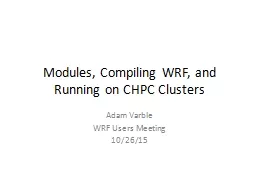PPT-Introduction - The basics of compiling and running on KNL
Author : kaptainpositive | Published Date : 2020-08-27
Zhengji Zhao User Engagement Group Cori KNL User Training February 12 2019 System Backlogs Cori KNL has a shorter backlog so for a better queue turnaround we recommend
Presentation Embed Code
Download Presentation
Download Presentation The PPT/PDF document "Introduction - The basics of compiling a..." is the property of its rightful owner. Permission is granted to download and print the materials on this website for personal, non-commercial use only, and to display it on your personal computer provided you do not modify the materials and that you retain all copyright notices contained in the materials. By downloading content from our website, you accept the terms of this agreement.
Introduction - The basics of compiling and running on KNL: Transcript
Download Rules Of Document
"Introduction - The basics of compiling and running on KNL"The content belongs to its owner. You may download and print it for personal use, without modification, and keep all copyright notices. By downloading, you agree to these terms.
Related Documents














